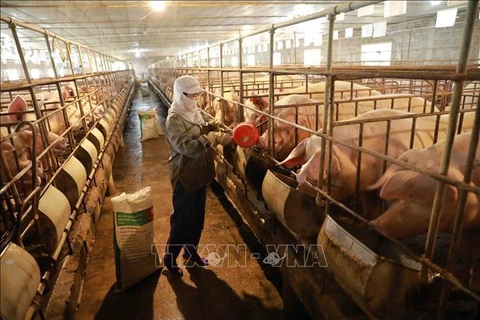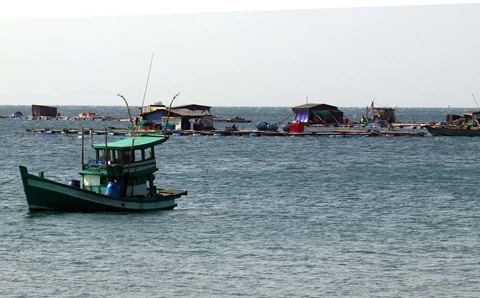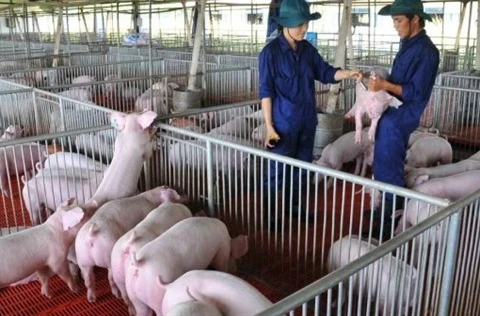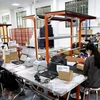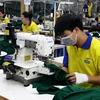 The development of disease-free zones has very important role to play in exporting animal husbandry products. (Photo: VietnamPlus)
The development of disease-free zones has very important role to play in exporting animal husbandry products. (Photo: VietnamPlus) Hanoi (VNA) - The Ministry of Agriculture and Rural Development is focusing on building and developing disease-free animal husbandry zones in the Southeast of the country, as it boasts large scale poultry and pig farming.
The animal husbandry sector, with constant annual growth recorded in its output and quality, has created the opportunity for increasing exports. However, to maintain and expand the markets, firms must control disease during processing in disease-free zones to meet the standards of the World Organisation for Animal Health (WOAH). Criteria on disease-free zones are a visa to export products in the animal husbandry sector.
VietnamPlus had an interview with Deputy Minister of Agriculture and Rural Development Phung Duc Tien on developing the disease-free zones, increasing the value of animal husbandry products towards broadening export markets.
Still a hard nut to crack
Reporter: Developing the disease-free zones plays a very important role in exporting animal husbandry products. Please tell us about the plan on developing disease-free animal husbandry zones?
Deputy Minister Phung Duc Tien: Under the regulations of the WOAH, the export of animal products and animals must follow regulations and criteria concerning the disease-free zones. If we wish to proceed to exporting, it is a must for us to observe those regulations.
In Vietnam, the disease-free zones have been built over the past many years and helped export animal husbandry products. The Republic of Korea, Hong Kong, and Japan are among the target destinations for pork and chicken respectively.
Currently, we have built the first criteria for the disease-free zones in the Southeast as the region has large scale poultry and pig farming. We have had disease-free zones and now it is a “hard nut to crack” to maintain and broaden them.
Reporter: What are the difficulties and challenges in building disease-free zones, especially since there are still small-scale farming households scattered in the zones?
Deputy Minister Phung Duc Tien: Animal husbandry in our country is small scale, the farming is performed in a spontaneous way and open sites are still popular. That is why biological and epidemic management remains a hard nut to crack. Worse still, the average vaccination coverage is not high, and this must be brought to over 80% to meet the criteria of a disease free zone.
The implementation of biological safety measures such as the distances of the stations, entries and exits, the treatment of waste and carcass disposal must follow strict process requirements. This creates challenges in building disease-free zones.
The small scale is sporadic, and the perception of people as well as of our political system on the building of the disease-free zones has yet to become intensive.
Reporter: In the context of numerous difficulties and challenges, in your opinion, what is the role of firms in accelerating the building of the disease-free zones?
Deputy Minister Phung Duc Tien: To develop agriculture, we must have an ecological system of farms, cooperatives and farmers that work together. A very valuable experience can be drawn from Europe which, in 2003 and 2004, abandoned the model of cooperatives and is now striving to restore it. Currently we are still maintaining the cooperative model and having an ecological system of firms that focus on sustainable development.
 Deputy Minister of Agriculture and Rural Development Phung Duc Tien said that to export, it is a must to build disease-free zones. (Photo: VietnamPlus)
Deputy Minister of Agriculture and Rural Development Phung Duc Tien said that to export, it is a must to build disease-free zones. (Photo: VietnamPlus) Large firms understand the significance of the building disease-free zones. However, to develop ecological system sustainably, firms must be pillars and pioneers to pull local farms and households into the building of disease-free zones.
Reporter: Besides the participation of firms, what should be done to connect localities in building the disease-free zones?
Deputy Minister Phung Duc Tien: Broadening and connecting the localities in building the disease-free zones, first of all, must come from perception. The Ministry of Agriculture and Rural Development will provide information on the number of the criteria and how to organise the localities.
The Ministry of Agriculture and Rural Development has held working sessions with the provinces, instructing the building of the disease-free zones. The provinces of Tay Ninh, Binh Phuoc and Dong Nai have been taking part in the work. We will make sure the work is done well in the time to come, to broaden the scale and ensure the criteria of disease-free zones for export products to other countries in strict observation of the regulations by the WOAH.
Four solutions to develop animal husbandry
Reporter: Along with the building of disease-free zones, please tell us what are the basic solutions to develop the animal husbandry sector towards increasing exports in the time to come?
Deputy Minister Phung Duc Tien: We must properly implement four solutions. The first is on breeding. Over the past many years, institutes, schools, research centres and firms have focused well on the work. Breeding pigs can produce 28,032 piglets per annum.
The second is on nutritious feed. The Prime Minister has instructed the building of an independent, self-reliant, and integrated economy, and the animal husbandry sector is no exception. The problem now is to build the sources of materials to hold the initiative in reducing costs for the lowest feed prices. Currently, feed costs are 65-70% of the product price.
 Small-scale animal husbandry causes difficulties to the building of disease-free zones. (Photo: VietnamPlus)
Small-scale animal husbandry causes difficulties to the building of disease-free zones. (Photo: VietnamPlus) The Ministry of Agriculture and Rural Development has instructed localities, especially the Central Highlands, to build zones of manioc, corn and soybean as materials. It is noteworthy that for maize, there are sufficient water supplies for farming zones. We can have a yield of 9.5-10 tonnes of corn per hectare, which is large in other countries. For the time to come, the Ministry of Agriculture and Rural Development has instructed the animal husbandry department and groups to prepare for the organiation of a conference on the development of material zones in the Central Highlands.
The third is on animal and plant medicine. Over the past many years, we have done well the prevention of diseases such as the vaccines against hoof-and-mouth and blue-ear disease. Most recently, we announced the large-scaled circulation of the vaccine against the African swine fever. As far as animal medicine is concerned, we must maintain the achievements and continue to research vaccines for various age groups.
And the fourth is the slaughtering, preliminary processing and processing. The model of Masan Group is a typical evidence showing that deep processing can raise the value by up to 31%. That is to say that besides the work on breeding, nutritious feed and medicine, firms must pay special attention to deep processing as it is very important.
Although we have exported chicken to many countries, including Japan, the volume is still limited. We must focus on the building of disease-free zones and the work of preliminary processing, slaughtering and processing so as to develop and broaden markets. The animal husbandry sector must not only serve the consumption by the 100 million people in Vietnam, but also consider the application of technology to a close and circular chain to serve export. Currently our farm produce has nearly 200 markets and there is no reason for the export of pork and poultry meat to fail in reaching more markets.
These are the basic solutions to raise the competitiveness, meet the domestic need and turn to export in the time to come. In 2022, export by the animal husbandry sector reached 409 million USD. So far this year, the figure is 232 million USD. This is a good sign, but we have to further our efforts to export products of the animal husbandry sector./.
Currently, the country counts 2,230 animal husbandry establishments and zones in 55 provinces and cities certified as free of diseases, of which 922 are for poultry, 1,133 for pig, and 175 for other domestic animals.
